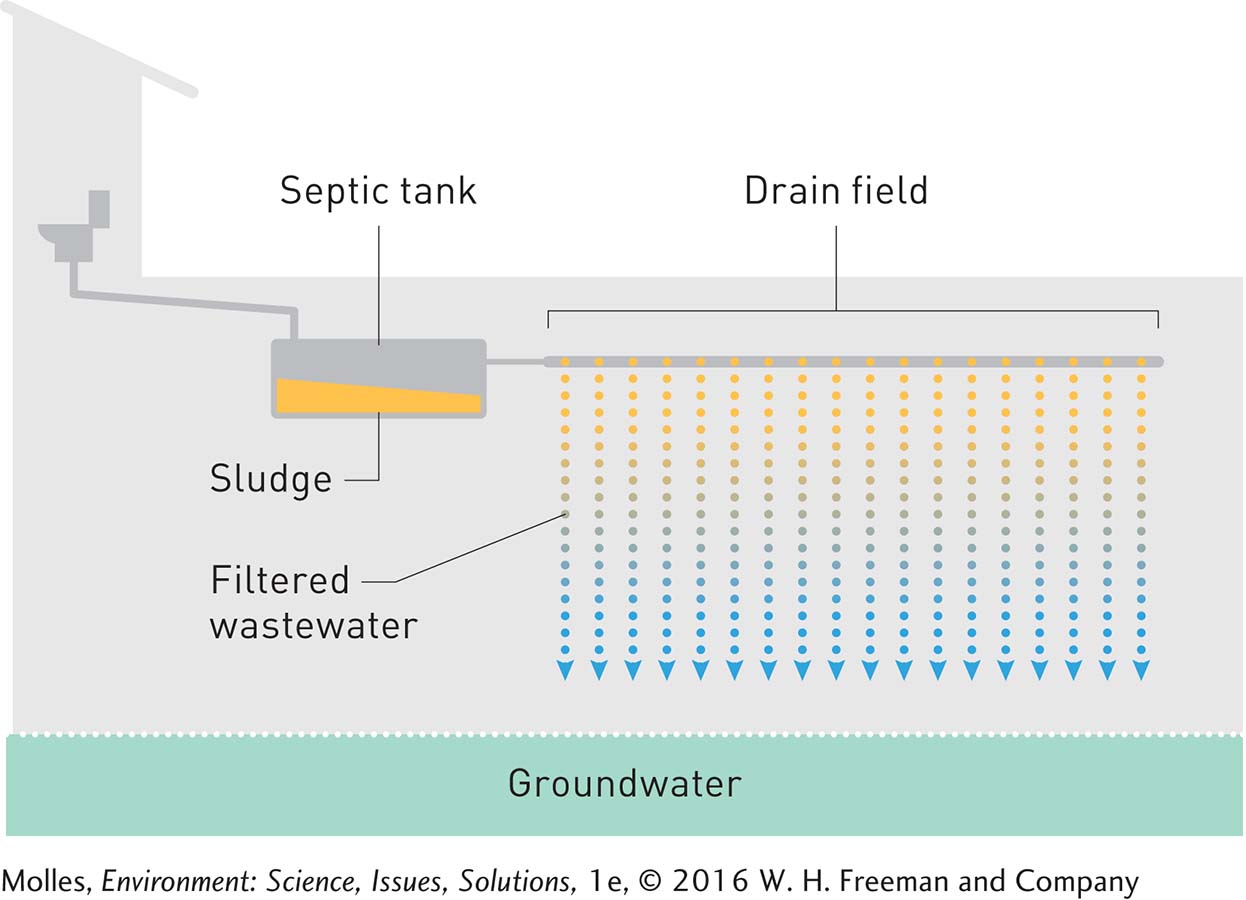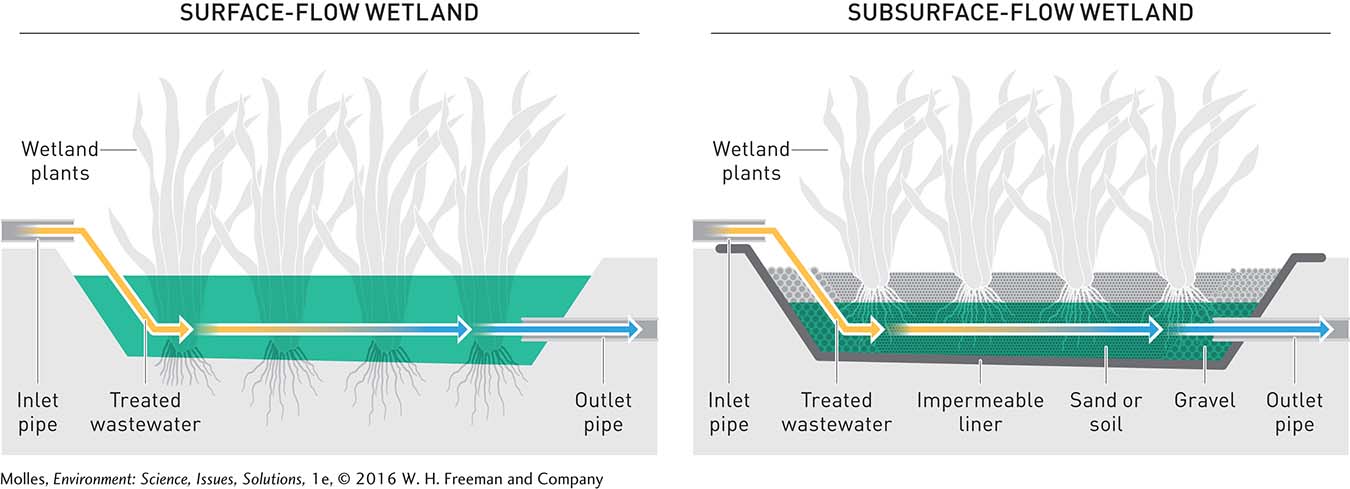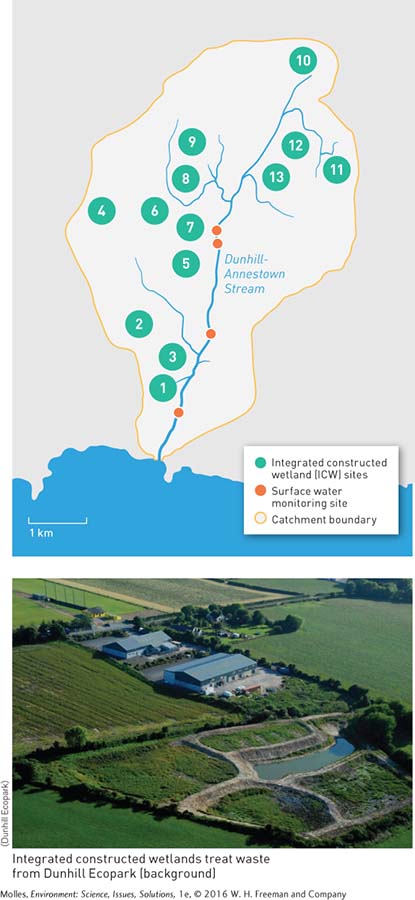13.12 There are many effective ways to reduce organic and nutrient pollution
Treating waste that contains large concentrations of organic matter and nutrients draws on both engineering principles and biological science. The methodology applied depends on whether the environment is urban or rural and whether it is found in a developed or developing country. The largest volumes of waste requiring treatment are produced in urban settings.
Sewage Treatment in Cities
Since city sewers are a major point source of organic and nutrient pollution, governments around the world monitor and regulate sewage treatment facilities. The EPA, for instance, requires all publicly owned sewage treatment facilities to provide a minimum of secondary treatment to wastewater, which removes some organic matter and nutrients from the water (Chapter 6). Members of the European Union and other developed countries have wastewater treatment standards that are similar to or higher than those of the United States. For example, most wastewater in Scandinavia receives tertiary treatment, which further reduces nutrient content and pathogens. In contrast, most wastewater in developing countries still receives little or no treatment before it gets discharged into the environment.
Septic Systems in Rural Areas
Rural residents across the United States and elsewhere rely on septic systems for treatment of domestic wastewater. Fortunately, a properly maintained septic system can effectively treat wastewater and prevent pollution of surface and groundwater. The most commonly used system in the United States directs all wastewater from a residence into a septic tank, which is watertight and generally buried (Figure 13.42). The appropriate volume of a septic tank depends on the size of the home it serves, but typical volumes range from 3,790 to 5,685 liters (1,000 to 1,500 gallons). As wastewater enters the septic tank, solids settle out, forming sludge, while grease and oils float to the surface. Naturally occurring bacteria will decompose most of the organic material in the septic tank, whereas any that resists decomposition will settle to the bottom of the tank as sludge. Sludge will gradually build up over time in septic tanks, so the tanks need to be pumped periodically to keep the septic system functioning properly. The frequency of pumping depends on the size of the tank and the volume of the waste it receives.


Why would a completely waterlogged soil preclude the use of a septic system for sewage treatment?
Water from a septic tank flows out into a drain field and percolates downward through the soil, where physical and biological processes purify it. For example, soil can act as a physical filter, removing bacteria and viruses from wastewater. Also, soil bacteria consume dissolved organic material carried by the wastewater and take up nutrients, including phosphorus and nitrogen. To be effective, the soils into which conventional septic systems discharge should be deep and well drained. Soils with lower permeability will require larger drain fields to ensure that wastewater can percolate through it without backing up and waterlogging the soil.
Constructed Wetlands to Treat Diverse Sources of Pollution
Agricultural land represents a major nonpoint source of organic and nutrient pollution. In addition to regulations aimed at reducing runoff from farms, we have long known that natural wetlands have the capacity to remove nutrients and other pollutants from water. In the early 1950s, scientists began to systematically experiment with artificially constructed wetlands to mimic those water purification qualities. The pioneer in this work was Käthe Seidel of the Max Plank Hydrobiological Institute, who had done her Ph.D. research on the common bulrush, Schoenoplectus lacustris (Figure 13.43). Despite conventional wisdom to the contrary, she documented bulrushes growing in highly acidic water, where it appeared to her that their presence improved the environment. From this observation Seidel, nicknamed “Bulrush Kate,” proposed that aquatic plants have the capacity to reduce water pollution—

Since Seidel’s pioneering work, constructed wetlands have become an effective, low-

Integrated Constructed Wetlands
Ireland has conducted some of the most comprehensive studies of constructed wetlands, where a concept called “integrated constructed wetlands” is applied to entire watersheds. Promoted by the Irish National Parks and Wildlife Service, integrated constructed wetlands improve aesthetics and increase habitat diversity while controlling nutrient pollution. The approach is most appropriate for use in small communities in rural or suburban settings.

Why might addressing the aesthetics of constructed wetlands be critical to their long-
In the 1990s, the waters around the town of Dunhill in southeastern Ireland were classified by the Irish Environmental Protection Agency as heavily polluted, due primarily to agricultural runoff. The watershed around Dunhill encompasses 25 square kilometers within which are 19 working farms, the village of Dunhill, and Annestown, located at the lower end of the watershed. To counter the problem, the county installed 13 integrated constructed wetlands (Figure 13.45). One wetland located below a 77-


While constructed wetlands can be harnessed to treat point sources of pollution, they are less useful for addressing the very diffuse nonpoint nutrient enrichment and organic pollution produced by many forms of agriculture. An effective way to reduce pollution from these nonpoint sources is to maintain riparian borders between fields and watercourses. Nor are constructed wetlands very efficient, in terms of land use, at the other end of the spectrum of agricultural production intensity, such as preventing pollution from large CAFOs. To effectively treat the waste stream from such operations, industrial-

Think About It
How do soil characteristics influence the effectiveness of septic systems for sewage treatment?
Why are constructed wetlands generally inappropriate for treating wastes from large CAFOs?
13.8–13.12 Solutions: Summary
Extreme pollution events in the mid-
Pollution control is achieved through both command-
The solution to reducing PCB release from contaminated sediments in the Hudson River was to dredge and remove them. Heavy metals can be removed from soils economically, using plants that accumulate them in their tissue. Organic pollutants can also be removed from contaminated soils and groundwater using microbial bioremediation. Centralized wastewater treatment facilities providing secondary or tertiary treatment can serve the needs of most people around the world. However, most rural residents across the United States and elsewhere, where treatment is required, rely on septic systems for treatment of domestic wastewater. Constructed wetlands can be an effective, low-